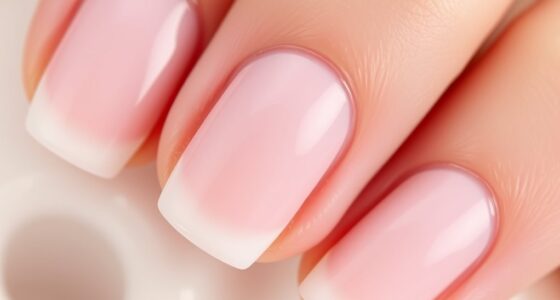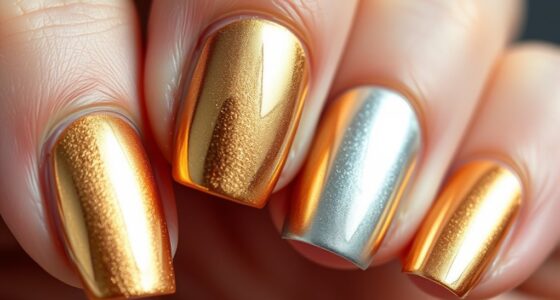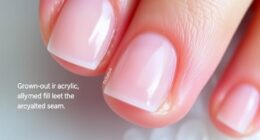Choosing the right nail file grit depends on your nail shape and what you want to accomplish. Use coarse grit (100-180) for heavy shaping or shortening, but handle carefully to avoid damage. Switch to medium (180-220) for smoothing edges and preparing nails for polish. Finish with fine grit (240+), which gives a smooth, polished look and prevents cracks. For detailed nail art or repairs, specialty grits are ideal. Continue to explore how each grit can help perfect your nails.
Key Takeaways
- Use coarse grit (100-180) for heavy shaping and shortening thick or stubborn nails.
- Opt for medium grit (180-220) for precise shaping and smoothing edges.
- Choose fine grit (240+) for finishing, polishing, and gentle nail surface refinement.
- Specialty grits (400-1000) are ideal for detailed nail art, gel removal, and repairs.
- Always select the appropriate grit based on nail type and task to prevent damage and promote healthy nails.
Understanding Nail File Grits: Types and Differences
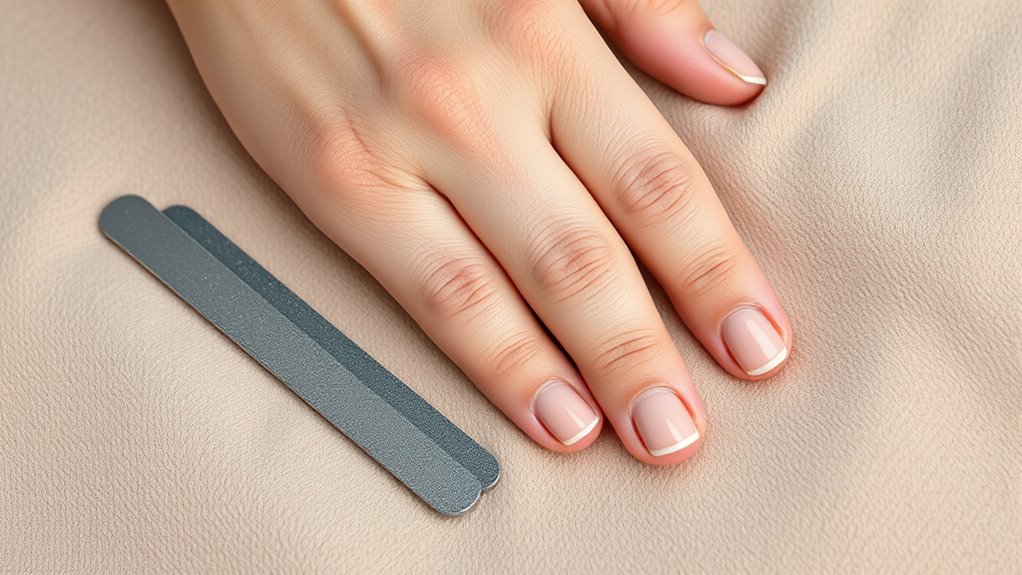
Understanding nail file grits is essential for choosing the right tool for your nail care needs. Different grits affect nail health and how effectively you can remove nail polish. Coarse grits, usually numbered 100 or below, are best for heavy shaping or shortening thick nails but can damage the nail surface if used too aggressively. Medium grits, around 180 to 220, are versatile for smoothing edges and preparing nails for polish. Fine grits, 240 or higher, are gentle and ideal for finishing touches and nail polish removal without harming the nail. Knowing these differences helps prevent unnecessary damage and promotes healthy nails. Using the correct grit for specific tasks guarantees your nails stay healthy and your polish removal is smooth and safe. Additionally, selecting the appropriate grit supports optimal nail health and ensures a safer, more effective manicure or pedicure experience. Proper selection also minimizes the risk of nail damage and contributes to overall nail strength. Understanding nail care techniques can further enhance your nail health and beauty.
Choosing the Right Grit for Shaping and Filing
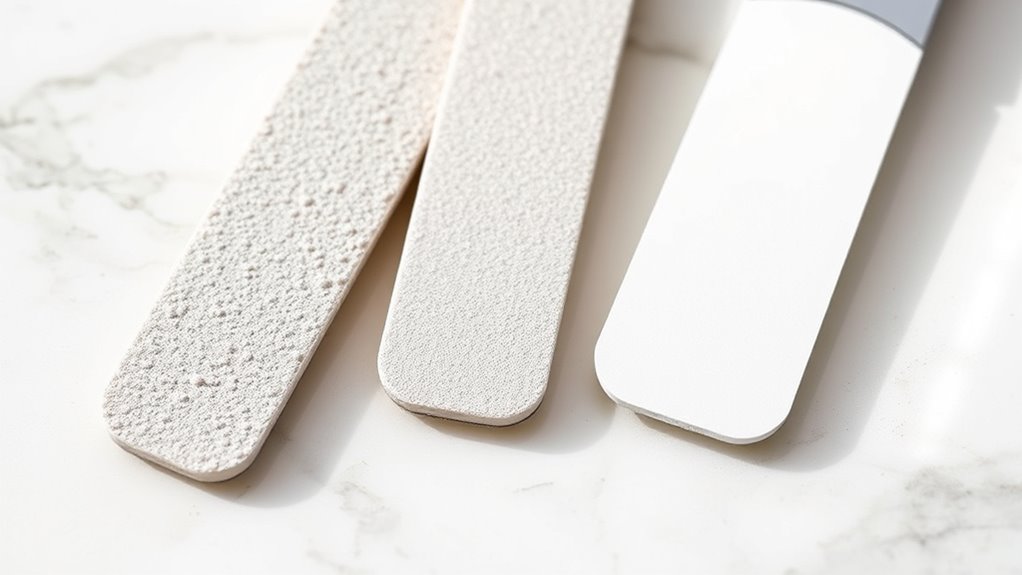
Choosing the right grit for shaping and filing depends on what you want to achieve with your nails. For aggressive shaping or reducing length, use a coarse grit (around 100-180). It helps you quickly reshape nails but requires careful handling to maintain nail care safety. For more precise shaping or gentle removal of excess, opt for a medium grit (180-220). This grit balances efficiency with safety, preventing damage. If you plan to apply nail polish afterward, ensure your file’s grit won’t create deep scratches that impact nail polish compatibility. Always choose a grit appropriate for your nail type and desired outcome, and handle the file carefully. Proper selection minimizes nail damage and ensures a smoother surface, making your nail care routine safer and more effective. Considering environmental considerations can also help you select eco-friendly tools that are safe for both your nails and the planet. Additionally, selecting eco-friendly tools aligns with the importance of sustainable practices in personal care routines. Selecting high-quality files with the appropriate grit can also reduce the need for frequent replacements, promoting more sustainable nail care routines.
Fine Grits for Smoothing and Finishing
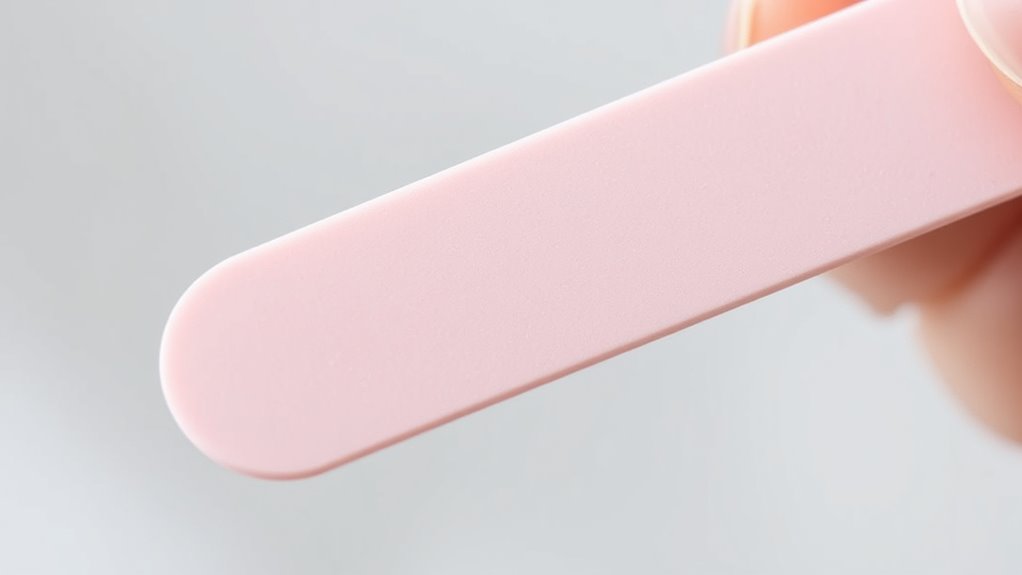
Fine grit files, typically ranging from 240 to 400 or higher, are essential for smoothing out rough edges and achieving a polished finish on your nails. Using these grits carefully can enhance your nail health by reducing splits and cracks. To maximize their benefits, keep these tips in mind: 1. Always file gently in one direction to prevent damage. 2. Regularly sanitize your files to maintain hygiene practices. 3. Finish with a fine grit to create a smooth, even surface, reducing peeling and chipping. 4. Being mindful of proper disposal methods can help prevent the spread of bacteria and maintain nail hygiene. Keeping your tools well-maintained ensures they function effectively and safely. Additionally, understanding supermarket hours can help you plan your shopping trips to acquire these essential tools conveniently. These steps help maintain healthy nails and prevent infections. Fine grit files are perfect for refining your nails after shaping, ensuring a sleek finish while supporting overall nail health. Proper use promotes hygiene and keeps your nails looking their best.
Specialty Grits for Nail Art and Repair
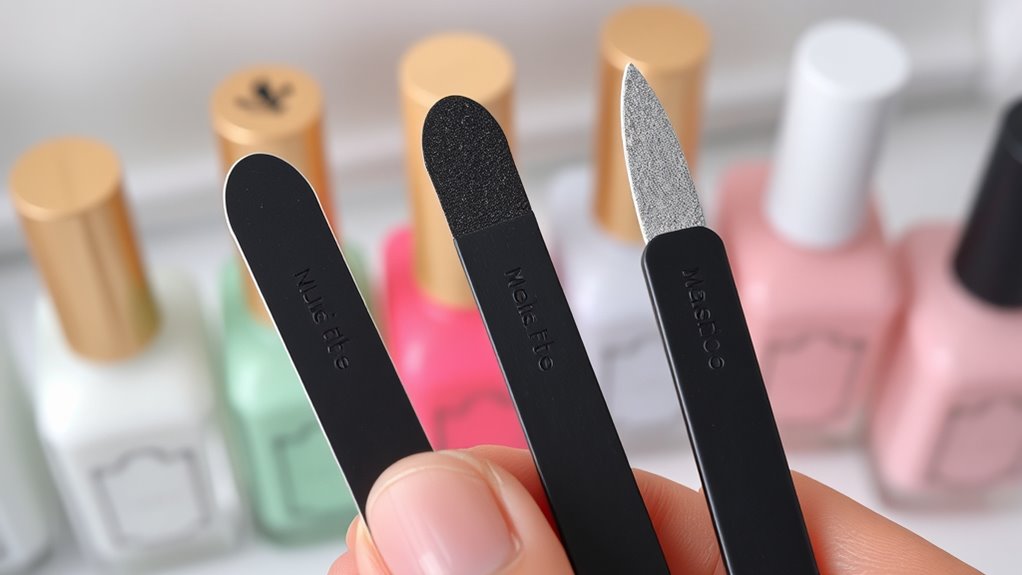
When you’re working on intricate nail art or repairing chips and cracks, specialty grit files become invaluable tools. They help with tasks like gel nail removal and acrylic nail prep, ensuring precision without damaging surrounding areas. These files often feature unique grit sizes designed for delicate work, such as detailing or smoothing edges after repairs. Use a finer grit for gentle shaping and a coarser grit for initial removal or prepping. Here’s a quick reference:
| Grit Type | Best For | Typical Use |
|---|---|---|
| 180 grit | Nail prep, smoothing edges | Light shaping |
| 240 grit | Final smoothing, detail work | Nail art finishing |
| 400 grit | Gel removal, fine polishing | Gentle finishing |
| 600 grit | Refining, polishing | Smooth surface prep |
| 1000 grit | High polish, shine | Final touches |
Additionally, understanding the horsepower of electric dirt bikes can inspire you to explore more efficient tools and techniques for achieving perfect nail finishes. Developing an understanding of specialty grit files helps you select the right tool for every step, ensuring your work is both precise and durable. Moreover, mastering the proper file grit for each task enhances your overall nail artistry and repair quality. It is also beneficial to familiarize yourself with the different grit types to optimize your workflow and results.
Tips for Proper Nail Filing Technique and Grit Maintenance
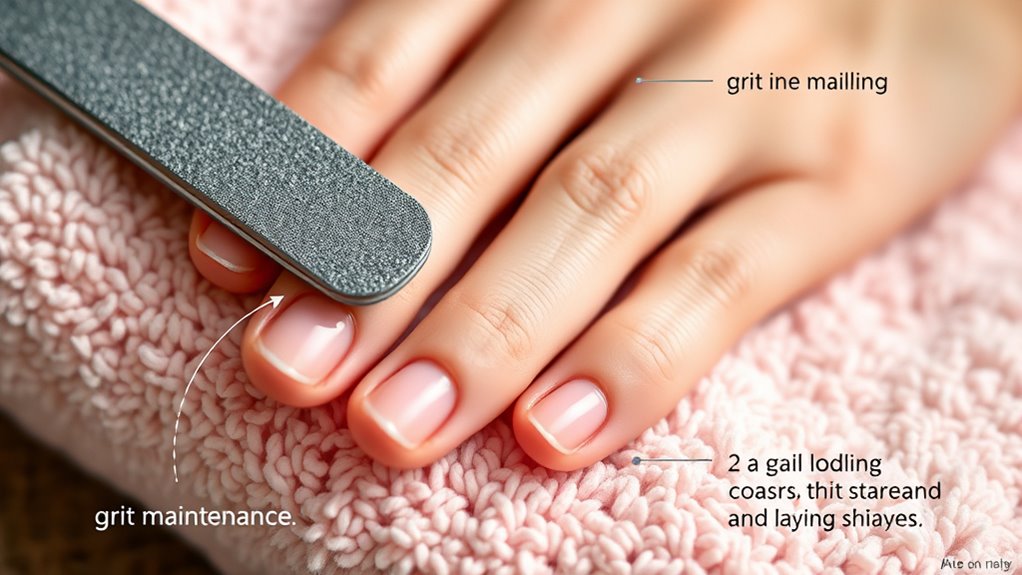
To achieve the best results when filing your nails, it’s essential to use proper technique and maintain your grit tools regularly. First, always file in one direction to prevent nail damage and keep your nail health intact. Second, avoid sawing back and forth, which can cause splitting. Third, clean your nail files after each use to prevent bacteria buildup and maintain their effectiveness. Regular grit maintenance ensures your tools stay sharp, reducing the risk of injury and promoting safer, healthier nails. Using the right grit for your nail type and following safety precautions helps avoid over-filing or damaging your nails. Proper technique and upkeep are key to achieving beautiful, healthy nails while protecting your nail health. Additionally, understanding nail file grit types and how to select the appropriate one can help you choose the best nail files for your needs. Maintaining your nail tool hygiene is also crucial for preventing infections and ensuring long-lasting performance.
To further safeguard your nail health, consider using appropriate nail care products that support nail strength and resilience.
Frequently Asked Questions
How Often Should I Replace My Nail Files Based on Grit Type?
You’re wondering how often to replace your nail files based on grit type. Typically, a nail file’s lifespan depends on usage and grit, but it’s best to follow a grit replacement schedule. For coarse grit files, replace every 2-3 months if used frequently, while finer grits can last longer. Regularly check for signs of wear, such as rough edges, to make sure your nail file remains effective and safe.
Can I Use the Same Grit for Natural and Artificial Nails?
You can’t always use the same grit for natural and artificial nails because nail file materials affect their compatibility. For natural nails, a softer grit works best, while artificial nails need a coarser grit to shape effectively. Mixing grits can damage your nails or weaken artificial ones. Always choose the right nail design compatibility by selecting the appropriate grit for each type, ensuring a smooth, healthy finish without causing harm.
Are There Specific Grits Recommended for Sensitive Skin?
Like a delicate brush stroke, gentle buffing suits sensitive skin perfectly. For sensitive skin care, opt for fine grit files—around 400 to 600 grit—that minimize irritation. These gentle grits help smooth nails without causing damage or discomfort, much like a whisper rather than a shout. Use these softer tools to maintain healthy, beautiful nails while respecting your skin’s delicate nature, ensuring a comfortable and effective nail care routine.
How Do Grit Differences Affect Nail Health Over Time?
Grit differences directly impact your nail health over time. Using a coarse grit can cause abrasion damage, weakening your nails and making them prone to breakage. Conversely, finer grits gently smooth your nails without compromising their strength. By choosing the right grit, you preserve nail integrity and prevent unnecessary damage. Properly cared-for nails stay stronger longer, reducing the risk of issues caused by harsh filing techniques.
Can Grit Types Influence the Longevity of Nail Polish?
Imagine your nails as a canvas for art; the right grit makes all the difference. Grit types influence nail polish adhesion and nail surface smoothness, directly impacting how long your polish lasts. Using a finer grit creates a smooth surface, helping polish stick better and preventing chipping. Conversely, a rougher grit can cause uneven surfaces, reducing longevity. Choose your nail file grit wisely to keep your manicure looking fresh longer.
Conclusion
Now that you know which nail file grits to use, imagine your nails as tiny canvases, each stroke shaping your unique style. Choosing the right grit feels like selecting the perfect brush—delicate for smooth finishes, rougher for quick shaping. With each gentle pass, you’re crafting a polished, flawless look that catches the light like a shimmering jewel. Embrace the process, and let your nails tell your story with every refined detail.



